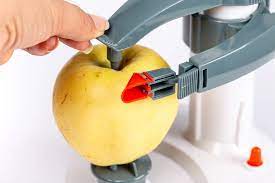Your Cart is Empty
FREE Worldwide Shipping! | +1 365 654 6605
FREE Worldwide Shipping! | +1 365 654 6605
March 07, 2024 4 min read

The apple slicer, a ubiquitous tool in modern kitchens, belies a rich and fascinating history. This seemingly simple device has revolutionized the way we prepare apples, transforming a once laborious task into a swift and efficient process. This article will journey through the annals of the apple slicer's history, its evolution, and its impact on food culture. In the earliest days of apple preparation, the task of peeling, coring, and slicing apples was a manual and time-consuming process. This arduous task required a certain level of skill to ensure the apple was not wasted, and the need for a more efficient method soon became apparent. This need gave birth to the invention of the apple slicer. The initial attempts to design efficient tools to aid in apple preparation can be traced back to the late 1700s. Families and communities would create and share these rudimentary tools during apple harvest season. These initial designs were simple, often consisting of a wooden plank and leather straps to spin the apple while a blade peeled its skin. In 1864, David Harvey Goodell, a New Hampshire native with a knack for invention, recognized the need for a more efficient apple preparation tool. He invented the first mechanical apple peeler, known as the "lightning apple parer." Despite initial slow sales, Goodell's invention quickly proved its worth. Frustrated by the lackluster marketing efforts of a New York firm, Goodell took matters into his own hands, becoming a traveling salesman who demonstrated the practicality and ease of his apple parer. His efforts paid off, with sales skyrocketing to 24,000 units in just three weeks. Goodell's original design was not the only one to emerge during this era of innovation. An estimated 250 apple-peeler designs were patented between 1803 and 1910, each offering unique features and improvements. The most notable among these was a patent granted to Albert J. Rice in January 1881. Rice's model featured spirally arranged slicing blades and curved rotary fingers, allowing for more efficient slicing and coring of the apple. During the late 1800s and early 1900s, the invention of the first plastic apple slicer also took place. Irvin I. Rubin, a chemist and manager at Robinson Plastics Company, developed a fruit slicer made entirely of plastic. Rubin's invention represented a new wave in plastic kitchenware, demonstrating the material's potential for creating durable, cost-effective tools. The invention of the apple slicer had a profound impact on food culture, particularly in American society. Apples, a staple in many households, could now be prepared more quickly and efficiently. This advancement facilitated the preservation of apples, with families able to easily peel, core, and slice large quantities of apples for drying or cooking into applesauce or apple butter. The apple slicer also played a significant role in the "back-to-the-landers" movement of the 1960s and 1970s. This movement promoted self-sufficiency and sustainability, with proponents seeking to live "off the grid" and provide for their own needs. Tools like the apple slicer made it easier for these individuals to preserve and prepare their homegrown produce, supporting their goals of self-reliance and reducing waste. Today, the apple slicer remains a popular tool in many kitchens. Modern designs often feature a circular cutting device attached to a handle. When pushed through the apple, it cores and slices the fruit into uniform pieces. Some models also peel the apple, providing an all-in-one solution for apple preparation. Despite advancements in design and functionality, the core purpose of the apple slicer remains the same — to simplify and expedite the process of preparing apples. As we continue to seek ways to make our lives more efficient, tools like the apple slicer serve as a reminder of how far we've come — and how something as simple as a kitchen gadget can have a profound impact on our daily lives. The apple slicer, from its humble beginnings to its modern incarnations, illustrates the power of innovation in transforming everyday tasks. As we continue to innovate and improve upon these tools, we carry forward the spirit of inventors like David Goodell and Irvin I. Rubin. Their ingenuity and determination have left a lasting legacy in our kitchens, making the once tedious task of apple preparation a swift and straightforward process.The Genesis of the Apple Slicer: A Journey Back in Time
Pre-Mechanical Era: Necessity Breeds Invention
The Birth of Mechanical Apple Slicer: A Revolutionary Invention
A Surge of Innovation: Diverse Designs and Advancements
The Cultural Impact of the Apple Slicer: Revolutionizing Food Culture
The Modern Apple Slicer: A Staple in Kitchens
Conclusion
References
Be the first to know about upcoming sales and promos. Get a 10% discount coupon when you subscribe!